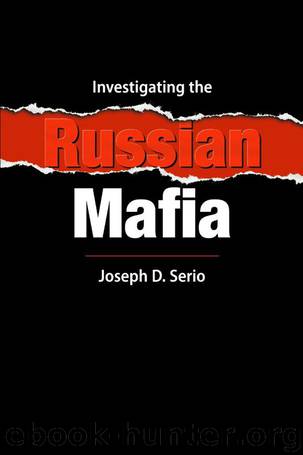Investigating the Russian Mafia by Joseph D. Serio

Author:Joseph D. Serio [Serio, Joseph D.]
Language: eng
Format: epub
ISBN: 9781594602252
Publisher: Carolina Academic Press
Published: 2012-08-20T23:00:00+00:00
Forbidden to have a family (postoyannaya sem’ya);
Forbidden to take up arms on behalf of the state;
Forbidden to cooperate with authorities as a witness or victim;
Obliged to contribute money for the common good.8
Three out of five of the laws pertained to the refusal to cooperate with the state in any form and would become the core of the vory tradition. This period was the first stage in the formation of new regulative traditions and customs while traditional attributive elements such as tattoos, jargon, nicknames, and gestures, as well as emotional elements like songs, verses, and sayings, remained more or less constant since bygone days.
Failure to unite internally resulted in conflicting philosophical viewpoints: one that defined ‘profession’ (traditional criminal) and one that leaned toward a system of subordination (zhigani—politicals). Toward the end of the 1920s and into the 1930s, a leadership crisis developed. The lower rungs of the hierarchy began to disobey the zhigani and promoted their own leaders, urki. Constant conflict between urki and zhigani created the need to perfect the code of the underworld. Based on pre-Revolution criminal traditions and customs, a single ‘law’ was accepted to regulate the behavior of top representatives of the criminal world. By this code, the most authoritative criminals became known as the vory v zakone, literally ‘thieves in law.’9
Correctional labor camps—the Gulag system—acted as the medium for further development of thieves’ traditions and customs and their swift dissemination throughout prison. Once released from prison, former inmates continued the propagation of the code and attracted greater numbers of adherents, which strengthened the vor’s authority and promoted group cohesion.10
By the 1930s, according to Likhachev, there had already developed an intricate set of rules prescribing behavior among thieves in a thoroughly hierarchical set of relationships. A thieves’ court with its own procedures was in place and “the penalty is always severe and inflicted without delay.”11
By the time the opening salvos of World War II sounded, vory v zakone were a potent force in the Soviet criminal world. The war, however, had a profound effect on the criminal community. Part of the thieves’ brotherhood responded to the call to defend the Motherland while others elected to remain in prison, true to their oath. At war’s end, those who had violated the code by taking up arms in support of the state attempted to reintegrate into the criminal world. Because of their defection from the criminal ranks, however, they were now considered turncoats or ‘bitches’ (suki)12 and forbidden to reclaim their authority. This tension among the elite led to the so-called bitches’ war (such’ya voina).13
The bitches’ war was a battle to the death in prison between criminals adhering to the thieves’ law and those who betrayed the code by taking up arms in the name of the state. The bitches supposedly introduced an alternative code at the end of World War II that allowed for collaboration with state authorities during the war in an attempt to regain the authority they had abandoned during the war.14
Soviet prison authorities attempted to
Download
This site does not store any files on its server. We only index and link to content provided by other sites. Please contact the content providers to delete copyright contents if any and email us, we'll remove relevant links or contents immediately.
Cecilia; Or, Memoirs of an Heiress — Volume 1 by Fanny Burney(31353)
Cecilia; Or, Memoirs of an Heiress — Volume 3 by Fanny Burney(30951)
Cecilia; Or, Memoirs of an Heiress — Volume 2 by Fanny Burney(30909)
The Great Music City by Andrea Baker(21669)
We're Going to Need More Wine by Gabrielle Union(18088)
Bombshells: Glamour Girls of a Lifetime by Sullivan Steve(13121)
Pimp by Iceberg Slim(12950)
All the Missing Girls by Megan Miranda(12779)
Fifty Shades Freed by E L James(12466)
Talking to Strangers by Malcolm Gladwell(11911)
Norse Mythology by Gaiman Neil(11904)
Crazy Rich Asians by Kevin Kwan(8375)
Mindhunter: Inside the FBI's Elite Serial Crime Unit by John E. Douglas & Mark Olshaker(7852)
The Lost Art of Listening by Michael P. Nichols(6485)
Enlightenment Now: The Case for Reason, Science, Humanism, and Progress by Steven Pinker(6416)
Bad Blood by John Carreyrou(5784)
The Four Agreements by Don Miguel Ruiz(5534)
Weapons of Math Destruction by Cathy O'Neil(5050)
We Need to Talk by Celeste Headlee(4882)
